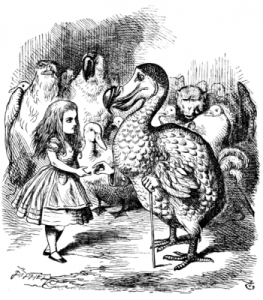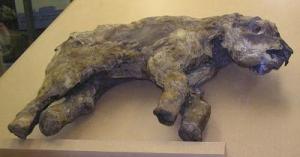On science blogs: HIV baby & resurrecting the extinct
HUGE, STUNNING, WORLD CHANGING?. Super-doc and super-writer Atul Gawande tweeted "This is huge, stunning, world changing." His professional opinion about the tale of the baby cured of HIV infection, only the second case on record. It appears that very early, very aggressive treatment with three antiretrovirals may have prevented formation of reservoirs, dormant cells that protect the virus from the drugs.
With the dust now settling, though, Gawande's joyful first response — and he was by no means alone — looks like hyperbole. Get the clinical details briefly from doc Paul Sax, whose blog HIV and ID Observations appears at Journal Watch. Sax also expresses bafflement at why the story has been so big, since he expects the implications for HIV infection in general will be nil, or close to it.
For one thing, this unique example doesn't mean that it's safe to go off antiretroviral therapy just because the baby did after 18 months and yet infection does not seem to have recurred. This was a point emphasized by Deborah Kotz at Daily Dose. The docs are cautiously calling it a "functional" cure because they can still find very low levels of viral DNA in the baby's cells.
At HealthNewsReview, Gary Schwitzer commended many accounts in the print dailies for their cautious caveats, but was not so happy with Charlie Rose and, especially, with Time.
At Spoonful of Medicine, Elie Dolgin reported that HIV specialists are hoping to study whether early aggressive treatment can work for other infants. The "cured" baby got three antiretrovirals beginning a couple of days after she was born. Common practice has been a single drug begun several weeks later.
They are also planning to meet in May to assess the possibility of a clinical trial of drug cessation in the young. The subjects would be children born with HIV who now have undetectable levels of virus. Antiretrovirals have pernicious side effects like bone demineralization and kidney failure, but conducting such a trial is riddled with problems both medical and ethical.
The best strategy is to prevent infant HIV infection in the first place. There's a proven tactic for doing that — treat HIV-infected pregnant women with antiretrovirals — which is why there are comparatively few HIV-infected infants in the US. The developing world is of course a different story; an estimated 1000 HIV-infected babies are born every day worldwide. Laura Newman at Double X Science explains why and how HIV-infected women (and men) can plan for a family without fear of an infected child. The post has lots of practical information about how to accomplish safe pregnancy, childbirth, and even breast-feeding, with links to many resources.
The HIV baby cure is a case study on why blogging can be absolutely essential for the story, whatever the story is. Informed bloggery can let in lots of light from the real world and add dimensions of analysis it would not be possible to get in any other way.
ON THE PAST — AND FUTURE — EVOLUTION OF HIV. At DNAScience, Ricki Lewis wondered whether HIV will eventually evolve into a human infectious organism that does very little damage. This appears to be what has happened to feline immunodeficiency virus, which is present in many domestic cats but doesn't make them very sick, at least for much of their lives. All of the lions in Serengeti National Park are infected with FIV, but none is sick.
This seems also to be the case with HIV's "parent," simian immunodeficiency virus, which is mostly harmless to some 40 species of monkeys and apes it infects. SIV is thought to have originated at least 12 million years ago and has even integrated into the prosimian genome — that's lemurs to you.
Current thinking is that HIV arose around the turn of the 20th Century. We can hope that it won't take 12 million years for it (and H. sap) to accumulate enough mutations to make HIV harmless to us. It is, after all, in an infectious organism's interest to keep its host in good enough shape to move around and transmit it to other hosts.
I wish that Lewis would consider carving this very intriguing section about lentivirus evolution out into a separate post. At present it's at the end of a long post (one of a series, I gather) that's mostly about adopting cats infected with FIV. I fear the evolution stuff will elude the radar of potentially interested readers whose initial reaction would be "Aaaarrrrrgh! Another blog post about cats!"
At least it's not a cat video. (='.'=)
DE-EXTINCTION: SHOULD THE EXTINCT BE RESURRECTED? This may be too late for most of us, but today, March 15, National Geographic is collaborating with TED in a day-long conference on what they are calling "de-extinction." Meaning whether extinct creatures should be cloned. Live-streaming begins at 8 a.m. Eastern time and runs 'til 5 p.m. I haven't been able to find out anything about possible archiving, so I don't know whether you can see it later on your own schedule.
There will, I imagine, be live-blogging. Find live tweets at a Twitter feed that is nearly as complex as cloning would be: #TEDxDeExtinction.
NatGeo's new blogging network is collaborating. Ed Yong contributes a 2012 post on cloning the wooly mammoth. Carl Zimmer, one of the speakers, has also done the April cover story on this topic. He has a long post about de-extinction as part of conservation efforts, especially as applied to the American chestnut tree.
Brian Switek explores some cloning prospects at Laelaps, but is worried about the ecological implications. The Ice Age is long gone. Where would a wooly mammoth live?
You might say that Virginia Hughes's post on new work on the Neanderthal/Neandertal brain at Only Human was at least somewhat related, since only a few weeks ago there was talk about resurrecting our long-dead kin. The paper she is writing about theorizes that Neandertals were not as socially adept as H. sap sap because they had to devote more of their big brains than we do to vision and body control. There are loads of complexities, and the researchers respond.
It will fascinating to see if this conference proposes a reasonable answer to the question I raised a few weeks ago when discussing the Neandertal cloning project: Why? So far the answer seems to be: Because it would be very, very cool.
SHIRT TALES: LET US ALL FALL BACK. I have ranted at length about Daylight Saving Time here in the past and also here. These semi-annual time changes are bad for the human brain and bad for circadian rhythms. What puzzles me most about the disruption to our lives from changing time twice a year is that it doesn't seem to have a political constituency. You never hear anyone ranting in its favor. And yet it persists. Inertia, no doubt. Due to deranged circadian rhythms.
Anyway, this is to alert you that there is now a petition to President Obama to keep the whole country on a single time — Standard or Daylight — year-round. Doesn't matter as long as there is no switching back and forth.
I am horrified to report that the petition has an embarrassingly erroneous hed: "Eliminate the bi-annual time change caused by Daylight Savings Time." Aaaaack! Semi-annual, people! Semi-annual!.
But please sign it anyway. It needs 100,000 signatures by April 4. Pass it on. Please.
SHIRT TALES: COCKTAIL PARTY PHYSICS. Jennifer Ouellette is now decorating her fine SciAm blog Cocktail Party Physics with Physics Week in Review, a roundup of relevant links. Here's this week's.
SHIRT TALES: SCIO13 VIDEO NOW ONLINE!. SciO13 video now online!





